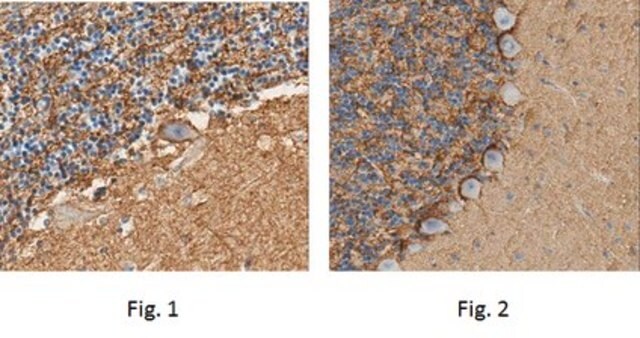A276
Monoclonal Anti-Na+/K+ ATPase (α Subunit) antibody produced in mouse
clone M7-PB-E9, ascites fluid
Sinónimos:
Anti-CMT2DD, Anti-HOMGSMR2
About This Item
Productos recomendados
biological source
mouse
Quality Level
conjugate
unconjugated
antibody form
ascites fluid
antibody product type
primary antibodies
clone
M7-PB-E9, monoclonal
mol wt
antigen ~110 kDa
species reactivity
canine, chicken, human, sheep, pig, bovine, mouse
should not react with
rat, Xenopus
technique(s)
immunocytochemistry: suitable
immunofluorescence: 1:20
immunohistochemistry (frozen sections): 1:100
immunoprecipitation (IP): suitable
indirect ELISA: suitable
western blot: 1:500-1:5000
isotype
IgG1
UniProt accession no.
shipped in
dry ice
storage temp.
−20°C
target post-translational modification
unmodified
Gene Information
human ... ATP1A1(476)
Categorías relacionadas
General description
Immunogen
Application
Biochem/physiol Actions
The different isoforms of the sodium/potassium ATPase exhibit tissue-specific and developmental patterns of expression. The α 1 and β mRNAs are present in all cell types examined, whereas the α 2 and α 3 mRNAs exhibit a more restricted pattern of cell-specific expression. The α subunit has been found in kidney, brain, heart, and to a lesser extent liver, skeletal and smooth muscle.
Target description
Physical form
Disclaimer
Not finding the right product?
Try our Herramienta de selección de productos.
Optional
Storage Class
13 - Non Combustible Solids
wgk_germany
WGK 1
flash_point_f
Not applicable
flash_point_c
Not applicable
ppe
Eyeshields, Gloves, multi-purpose combination respirator cartridge (US)
Certificados de análisis (COA)
Busque Certificados de análisis (COA) introduciendo el número de lote del producto. Los números de lote se encuentran en la etiqueta del producto después de las palabras «Lot» o «Batch»
¿Ya tiene este producto?
Encuentre la documentación para los productos que ha comprado recientemente en la Biblioteca de documentos.
Nuestro equipo de científicos tiene experiencia en todas las áreas de investigación: Ciencias de la vida, Ciencia de los materiales, Síntesis química, Cromatografía, Analítica y muchas otras.
Póngase en contacto con el Servicio técnico







